Congratulations - you have completed .
You scored %%SCORE%% out of %%TOTAL%%.
Your performance has been rated as %%RATING%%
Your answers are highlighted below.
Question 1 |
Northern elephant seals were hunted by humans in the 1890s, reducing their population size to 20 individuals. Even though their population is now over 30,000, the seals still have reduced genetic variation. What’s the best explanation of this phenomenon?
Bottleneck effect | |
Founder effect | |
Heterozygote advantage | |
Relative fitness |
Question 1 Explanation:
the correct answer is (A). A severe drop in population size can cause a bottleneck effect. In this case, certain alleles were overrepresented in the population of survivors, and other alleles were underrepresented.
Question 2 |
Certain cavefish and salamanders have non-functional eyes, which are remnants of the functional eyes of their ancestors. Such examples of “leftover” structures are referred to as:
Homologous structures | |
Analogous structures | |
Vestigial structures | |
Genetic drift |
Question 2 Explanation:
The correct answer is (C). Vestigial structures are of little, if any, importance to the fitness of the organism. They are historical remnants of structures that promoted fitness in their ancestors.
Question 3 |
Which scientists tested the hypothesis that Earth’s early atmosphere was a reducing environment in which organic compounds could have formed from simple molecules?
Oparin and Haldane | |
Miller and Urey | |
Cech and Altman | |
Conway and Morris |
Question 3 Explanation:
The correct answer is (B). In 1953, Miller and Urey, of the University of Chicago, tested the Oparin-Haldane hypothesis by creating laboratory conditions similar to those that the scientists at the time thought existed on early Earth.
Question 4 |
What is the phenomenon that explains the sudden appearance of many phyla of living animals in the fossil record, between 535–525 million years ago?
Cambrian Explosion | |
Continental Drift | |
Anagenesis | |
Permian Mass Extinction |
Question 4 Explanation:
The correct answer is (A). The Cambrian explosion is the period of time occurring 535–525 million years ago in which large, hard-bodied forms of animals with most of the major body plans known today appeared in the fossil record.
Question 5 |
The first cells on Earth were likely to be:
Amino acids | |
Protobionts | |
Ribozymes | |
Anaerobic prokaryotes |
Question 5 Explanation:
The correct answer is (D). None of the other choices are “cells.” It is likely that the first cells were anaerobic heterotrophic prokaryotes that obtained nutrients by absorbing organic molecules from the surrounding environment.
Question 6 |
Which of the following is not a step in the formation of the first living cells?
The biotic synthesis of small organic molecules | |
The packaging of molecules into droplets with membranes that maintained an internal chemistry different from their surroundings | |
The joining of small molecules into macromolecules | |
The origin of self-replicating molecules that eventually made inheritance possible |
Question 6 Explanation:
The correct answer is (A). Since this is asking for the steps leading to the formation of the first living cells, the correct answer would be: “The abiotic synthesis of small organic molecules.”
Question 7 |
In zebras, the striped pattern is determined by a series of genes that “turn on” the production of melanin (a dark pigment) on only certain parts of the body. This timing differs between species, and explains why different species of zebras have different types of striping. For example, Plains zebras have relatively wide stripes, yet Grevy’s Zebra has relatively narrow stripes.
This is an example of:
Homeotic genes | |
Paedomorphosis | |
Heterochrony | |
Evolutionary novelties |
Question 7 Explanation:
The correct answer is (C). Heterochrony is an evolutionary change in the rate or timing of developmental events.
Question 8 |
Three million years ago, populations of snapping shrimp were separated on either side of Central America when the Isthmus of Panama closed, creating a land bridge between North and South America. Researchers found that snapping shrimp on one side of the isthmus appeared nearly identical to those on the other side. It is believed that the separate populations were once members of the same population. When researchers put males and females from different sides of the isthmus together, they snapped at each other aggressively instead of mating.
Which of the following best describes what happened to the snapping shrimp as evidenced by the aggression observed?
Sympatric speciation brought about by polyploidy | |
Hybridization caused by geographic isolation | |
Allopatric speciation caused by geographic isolation | |
Coevolution brought about by habitat isolation |
Question 8 Explanation:
The correct answer is (C). Allopatric speciation occurs when one species is divided into two. The original population is physically separated into two subpopulations and the two groups live in different locations. Over time, the gene pools of the isolated populations continue on their own evolutionary paths. Eventually, the populations are no longer able to interbreed if they ever come together again. This is one of the main processes by which new species arise.
Question 9 |
Bowerbirds of Australia and New Guinea have one of the most unique courtship rituals in the animal kingdom. A great bowerbird (Chlamydera nuchalis) makes a bower with colorful and unique objects, such as glass, and pieces of litter. The male golden-fronted bowerbird (Amblyornis flavifrons) will decorate his bower with colorful fruit. The Vogelkop bowerbird (Amblyornis inornata) makes a cone-shaped bower that can reach a meter high. He decorates the entrance to his bower with bright flowers.
Evolutionary changes in mating rituals, like the differences in bower construction by the bowerbirds, can contribute to which of the following:
Intrasexual selection | |
Speciation | |
Genetic drift | |
Bottleneck effect |
Question 9 Explanation:
The correct answer is (B). If two species evolve different mating rituals, it may permanently isolate them from one another and complete the process of speciation.
Question 10 |
Three-spine sticklebacks were introduced to a lake in Switzerland over 150 years ago. Since that time, the fish have begun splitting into two separate types. One group lives in the main lake, and the other group lives in the streams that flow into it. The main lake dwellers are larger, with longer spines and tougher armor. Both types of fish breed in the same streams at the same time of the year, yet they are splitting into two genetically and physically different types.
How would evolutionary biologists classify this type of speciation?
Sympatric | |
Allopatric | |
Reproductive isolation | |
Hybridization |
Question 10 Explanation:
The correct answer is (A). Sympatric speciation occurs in populations that live in the same geographic regions.
Question 11 |
Western spotted skunks (Spilogale gracilis) breed in the fall, whereas and eastern spotted skunks (Spilogale putorius) breed in late winter. What type of reproductive barrier prevents these species from being classified as the same species?
Habitat isolation | |
Mechanical isolation | |
Gametic isolation | |
Temporal isolation |
Question 11 Explanation:
The correct answer is (D). Species that breed during different seasons, times of the day, or different years cannot mix their gametes.
Question 12 |
Which of the follow scenarios describes allopatric speciation?
A small segment of the original population is exposed to different environmental conditions, and a new subspecies emerges through natural selection. Over time, a new species is formed without geographic isolation. | |
A population of species enters a new niche or habitat at the edge of the parent species’ range. There is no physical barrier between the populations, but the occupancy of a new niche becomes a barrier to gene flow between the parent population and the new population. | |
Rapid and abrupt species formation from genetic drift or chance. | |
Part of the population becomes geographically isolated from the main population, separating the population into two isolated groups. The populations become two distinct species. |
Question 12 Explanation:
The correct answer is (D). Allopatric speciation occurs when gene flow is interrupted because the population has been divided into geographically isolated subpopulations.
Question 13 |
In the early 1900s, three species of wildflowers were introduced to the United States from Europe. When the species crossed with each other they often produced sterile hybrids. However, after about 50 years, two new varieties were growing, both able to reproduce their own kind but not able to reproduce with any of the original three species. After researching how this came to be, it was discovered that a mutation occurred that resulted in the parental plants producing gametes with two or more sets of chromosomes. When these gametes fused with other gametes the result was offspring with additional sets of chromosomes.
This type of speciation occurred due to:
Polyploidy | |
Diploidy | |
Genetic recombination | |
Polygenic inheritance |
Question 13 Explanation:
The correct answer is (A). Polyploidy is a condition in which a cell is formed that has an extra set(s) of chromosomes.
Question 14 |
The “oxygen revolution” had an enormous impact on life, and likely
Provided the proper environment for packaging molecules into “protobionts” | |
Caused RNA molecules with certain base sequences to become more stable and replicate faster | |
Caused the extinction of many prokaryotic groups due to the rising concentration of O2 | |
Resulted from the sudden appearance of animals in the Cambrian period |
Question 14 Explanation:
The correct answer is (C). In certain chemical forms, oxygen attacks chemical bonds and can inhibit enzymes and damage cells. This rising concentration of O2 probably killed many groups of prokaryotes, except for species surviving in habitats that remained anaerobic.
Question 15 |
It is hypothesized that eukaryotic features evolved from prokaryotic cells when smaller prokaryotic cells, the precursors of mitochondria and plastids, began living within larger cells. This model is referred to as:
Endosymbiosis | |
Adaptive radiation | |
Simple metabolism | |
The Cambrian explosion |
Question 15 Explanation:
The correct answer is (A). An endosymbiont is a cell that lives within larger cells. It is believed that prokaryotic ancestors of mitochondria and plastids probably entered the host cell as undigested prey or internal parasites.
Question 16 |
In which nutrient cycle does bacteria play a key role in the conversion of an essential organic compound from its atmospheric form to a form usable by organisms?
The water cycle | |
The carbon cycle | |
The nitrogen cycle | |
The phosphorus cycle |
Question 16 Explanation:
The correct answer is (C). In the nitrogen cycle, nitrogen-fixing bacteria convert nitrogen gas (N2), which is not usable by plants, to a form that is usable by plants. These nitrogen-fixing bacteria reside in the root nodules of legumes.
Question 17 |
Male peacocks are famous for their colorful, showy tails, whereas female peahens are brown with no fancy tails. This is an example of sexual dimorphism, found in organisms with two different looks within the species. What mode of selection produces species exhibiting sexual dimorphism?
Stabilizing selection | |
Directional selection | |
Sexual Selection | |
Artificial selection |
Question 17 Explanation:
The correct answer is (C). Sexual selection can lead to the evolution of characteristics, both phenotypic and behavioral, that have an adverse impact on survival but promote fitness.
Question 18 |
Thermoregulation involves maintaining an internal body temperature within a tolerable range. Which of the following organisms are considered ectothermic?
Mallard duck | |
Walrus | |
Python | |
Bat |
Question 18 Explanation:
The correct answer is (C). Snakes gain most of their heat from an outside source, making them ectotherms.
Question 19 |
Which types of animals excrete nitrogenous waste in the form of ammonia?
Fish | |
Mammals | |
Birds | |
Reptiles |
Question 19 Explanation:
The correct answer is (A). Animals that excrete ammonia need access to lots of water because ammonia can only be tolerated at very low concentrations.
Question 20 |
Which of the following statements does not describe natural selection:
If a group of organisms relocates to a new environment, or if its current environment changes, the organisms that have a higher fitness in the new environment will leave more offspring and may, over time, give rise to a new species. | |
Humans have modified many species by selectively breeding individual species to develop new species with specific, desired characteristics. | |
Individual organisms with certain characteristics are more fit for their environment than organisms without certain characteristics. The organisms with the best suited characteristics for their environment will live to reproduce, and pass those characteristic on to their offspring. | |
Natural selection can increase the proportion of favorable traits in a population. |
Question 20 Explanation:
The correct answer is (B). Choice (B) explains artificial selection, the selective breeding of domesticated organisms to increase the expression of desired traits.
Question 21 |
Sickle Cell Disease is caused by having two alleles for Hemoglobin S. The Hemoglobin S allele results red blood cells that have a “sickle” shape. Individuals who have one Hemoglobin S allele and one Hemoglobin B allele are said to be “carriers”. Although they have the sickle cell trait, they do not have sickle cell disease. Carriers are resistant to malaria. The Hemoglobin S allele is found most frequently in individuals who have ancestry tracing to the parts of Africa where malaria was more common.
This type of evolutionary fitness is referred to as:
Diploidy | |
Heterozygote advantage | |
Frequency dependent selection | |
Neutral variation |
Question 21 Explanation:
The correct answer is (B). Heterozygote advantage is exhibited in individuals who are heterozygous for a particular trait, and gives the carrier of the trait greater fitness.
Question 22 |
White-tailed deer vary in color from reddish brown in the summer to grayish brown in the winter. However, one percent of the deer population exhibit a recessive genetic trait found in about one percent of all white-tailed deer called leucism. Leucistic white-tailed deer lack pigment over all or part of their bodies. They can have varying levels of white, from having white splotches, to being half brown and half white, to appearing nearly all white. Since a leucistic deer is not very well camouflaged, their chance of survival is very low. The color range of white-tailed deer can be graphed with the following results:


Which of the following statements best indentifies the type of selection resulting in the typical reddish brown to grayish brown coat of white-tailed deer?
Directional selection | |
Disruptive selection | |
Stabilizing selection | |
Artificial selection |
Question 22 Explanation:
The correct answer is (C). Stabilizing selection removes extreme variants (white coat) from the population and preserves the intermediate phenotypes (reddish brown to grayish brown).
Question 23 |
Questions 23–25
Mycosphaerella graminicola causes a disease known as speckled leaf spot on wheat. This disease has the potential to cause significant grain loss if the environmental conditions are favorable for their spread. Scientists determined the genetic structure of this pathogen in various geographic regions world-wide and found that all populations collected from different geographic locations had similar frequencies of common alleles except the populations collected from Australia and Mexico. Below are the results:
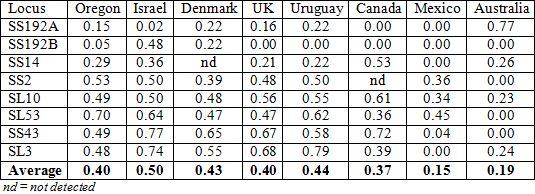

The Mexican population had significantly lower gene diversity, few alleles at each locus, and the gene frequencies were significantly different from populations at other locations. The Mexican population was sampled from a breeding nursery used to screen for resistance to this pathogen. The nursery is located far away from the wheat population area and has a limited potential for influx of natural inoculation, and was inoculated with a limited number of strains of the pathogen. This is an excellent example of:
Founder Effect | |
Bottleneck Effect | |
Natural Selection | |
Balancing Selection |
Question 23 Explanation:
The correct answer is (A). Founder effect occurs when a few individuals have been isolated from a larger population, and thus a smaller group of individuals establishes a new population whose gene pool differs from the source population. In this case, the Mexican population of the speckled leaf spot was isolated from the general population. This presents a clear example of genetic drift due to a small founding population.
Question 24 |
Mycosphaerella graminicola causes a disease known as speckled leaf spot on wheat. This disease has the potential to cause significant grain loss if the environmental conditions are favorable for their spread. Scientists determined the genetic structure of this pathogen in various geographic regions world-wide and found that all populations collected from different geographic locations had similar frequencies of common alleles except the populations collected from Australia and Mexico. Below are the results:


In Australia, only a relatively small number of individuals arrived on this continent with the introduction of modern agriculture, and therefore
It is likely that a sudden change in the environment caused a bottleneck effect | |
Mutations resulting from natural selection have created new pathogens in the original strain | |
The low gene diversity is consistent with the founder effect | |
The transfer of alleles into a new population |
Question 24 Explanation:
The correct answer is (C). With the introduction of modern agriculture to Australia, a few individuals of the speckled leaf spot were isolated from the larger population, and thus less genetic diversity was present.
Question 25 |
Mycosphaerella graminicola causes a disease known as speckled leaf spot on wheat. This disease has the potential to cause significant grain loss if the environmental conditions are favorable for their spread. Scientists determined the genetic structure of this pathogen in various geographic regions world-wide and found that all populations collected from different geographic locations had similar frequencies of common alleles except the populations collected from Australia and Mexico. Below are the results:


The geographic area with the highest level of gene diversity speckled leaf spot is likely to be the center of origin. Based on this data, that area would be
Europe | |
Asia | |
Middle East | |
North America |
Question 25 Explanation:
The correct answer is (C). Israel has the highest average gene diversity, and is likely to be the center of origin.
Question 26 |
A study published by a team led by the U.S. Geological Survey (USGS) revealed the movement of polar bears toward areas with more persistent sea ice. The researchers defined four general polar bear population clusters: Eastern Polar Basin, Western Polar Basin, Canadian Archipelago, and Southern Canada. By looking at the genes of the polar bears, they found that the polar bears have recently begun to move in a northward direction, from Southern Canada and Eastern Polar Basin into the Canadian Archipelago. The team of researchers hypothesized that the Canadian Archipelago will be a future refuge for polar bears if climate change continues to trend toward a warmer climate.
This movement of polar bear populations provides a prime example of
Gene Flow | |
Neutral Variation | |
Directional Selection | |
Founder Effect |
Question 26 Explanation:
The correct answer is (A). Gene flow is the movement of allele frequencies into or out of a population due to the movement of fertile individuals and their gametes.
Question 27 |
Which of the following was not a large-scale process which influenced major evolutionary changes in life on Earth?
Adaptive radiation | |
The founder effect | |
Continental drift | |
Mass extinctions |
Question 27 Explanation:
The correct answer is (B). The founder effect is genetic drift that occurs when a few individuals from a larger population become isolated and form a new population with a less genetically diverse gene pool than the original population. Adaptive radiation, continental drift and mass extinctions are all major large-scale process that influenced major changes to life on earth.
Question 28 |
Evidence from which of the following does not support evolution:
Homology | |
Direct observation of natural selection | |
Fossil record | |
Analogy |
Question 28 Explanation:
The correct answer is (D). Analogous structures are similarities that are not attributable to common ancestry.
Question 29 |
The fossil record is a significant record of the history of life, but it is an incomplete record of evolutionary change. Many fossils have been destroyed by geologic processes and many are yet to be discovered. As a result, the known fossil record is biased in favor of species with certain characteristics. Which of the following is not a characteristic that would be included in the fossil record?
Species that were abundant | |
Species with hard shells | |
Species that existed for short periods of time | |
Species that were widespread |
Question 29 Explanation:
The correct answer is (C). The less time a species exists the less likely it is to become a component of the fossil record.
Question 30 |
In animal development, which stage of embryonic development involves the rearrangement of the blastula into a three-layered embryo?
Cleavage | |
Gastrulation | |
Organogenesis | |
Fertilization |
Question 30 Explanation:
The correct answer is (B). Gastrulation takes place when the blastula-stage embryo folds inward (through a series of tissue and cell movement) to create a three-layered embryo, called the gastrula. Cleavage is the first stage, involving the creation of the blastula (hollow ball of cells) through cell division. Organogenesis is the stage during which the three layers of the gastrula form rudimentary organs. Fertilization takes place before embryonic development.
Question 31 |
Which group of tissues or organs most likely derived from the ectoderm layer during embryonic development in vertebrates?
Epithelial living of the digestive tract | |
Circulatory and lymphatic systems | |
Epithelial lining of the mouth and anus | |
Thyroid and parathyroid glands |
Question 31 Explanation:
The correct answer is (C). The ectoderm is the outer layer of the gastrula and forms. The epithelial lining of the mouth and anus are formed from the ectoderm. The endoderm lines the embryonic digestive tract and the thyroid and parathyroid glands, among other things. The mesoderm partly fills the space between the endo- and ectoderms. The circulatory and lymphatic system arise from the mesoderm, among other tissues and organs.
Question 32 |
What is the unique family of genes in animals that plays an important role in the development of embryos, and controls the expression of other genes influencing animal morphology?
FOXP2 | |
Hox | |
Mads-box | |
α-globin and β-globin |
Question 32 Explanation:
The correct answer is (B). Hox genes provide information about the location of tissues and organs during development. FOXPS functions in the vocalization of vertebrates. Mads-box genes are involved in flower development. α-globin and β-globin gene families are components of human hemoglobin.
Question 33 |
Which group of organisms share these four key characteristic at some stage of their development: notochord; dorsal, hollow nerve cord; muscular, post-anal tail; and pharyngeal slits?
Angiosperms | |
Archaeans | |
Vertebrates | |
Chordates |
Question 33 Explanation:
The correct answer is (D). Chordata is the phylum to which vertebrates belong along with the Craniata (such as hagfish), Unichordata (such as tunicates), Cephalochordata (such as lancelets), and, possibly, echinoderms. All chordates have the listed characteristics as defining features. Archaeans are unicellular prokaryotes. Angiosperms are flowering plants, and do not have any of the listed characteristics.
Question 34 |
Which of the following is the longitudinal, flexible rod located between the digestive tract and nerve cord in chordates?
Notochord | |
Dorsal, hollow nerve cord | |
Muscular, post-anal tail | |
Pharyngeal slits |
Question 34 Explanation:
The correct answer is (A). The notochord is a skeletal structure present at some point in all chordate development. It forms a longitudinal, flexible rod between the digestive tract and the nerve cord. The dorsal, hollow nerve cord forms the central nervous system. The post-anal tail extends beyond the anus in embryonic development. The pharyngeal slits may be modified into gill slits in aquatic organisms or into areas of the ear and structures in the head and neck in tetrapods.
Question 35 |
Which group of mammals lays eggs?
Marsupials | |
Monotremes | |
Eutherians | |
Amniotes |
Question 35 Explanation:
The correct answer is (B). Monotremes include the platypus and spiny anteaters. They lay eggs. Marsupials are born very early and complete their development while nursing. Examples include opossums, kangaroos and koalas. Eutherinas, or placental mammals, have a long pregnancy and complete their embryonic development in the mother’s uterus. Although monotremes are amniotes, not all amniotes lay eggs.
Question 36 |
Mule deer live and feed in predominately open areas in the mountains of western North America, where there is slightly less food available than on the forest edge. However, the risk of predation by mountain lions near the forest edge is greater than in the open, unforested areas where they feed.
What theory describes this cost-benefit compromise that favors the behavior that minimizes the costs of feeding and maximizes the benefits?
Cross-fostering | |
Optimal foraging model | |
Associative learning | |
Proximate causation |
Question 36 Explanation:
The correct answer is (B). The optimal foraging model is used to predict behaviors that maximize the benefits (eating grass) of a feeding behavior while minimizing both the energy expended obtaining the food and the risks associated with (getting eaten by a mountain lion) obtaining the food. Cross-fostering refers to a method used by researchers to determine which environmental conditions contribute to behavior. Associative learning is the ability to associate one environmental feature with another, such as learning that yellow and black flying insects sting. Proximate causation looks the immediate cause of a behavior.
Question 37 |
In some animal societies, such as honeybees, a single female mates with several males. This is referred to as:
Monogamous | |
Polygyny | |
Polyandry | |
Polygenetic |
Question 37 Explanation:
The correct answer is (C). Polyandry is a relationship in which one female mates with multiple males. Monogamous relationships involve mates that remain together for a long period of time. Polygyny is a relationship in which one male mates with multiple females. Polygenetic, as in polygenetic inheritance, refers to the effect of two or more genes on a single phenotypic character.
Question 38 |
As tadpoles change into frogs, their tails get smaller and smaller as the cells die and are engulfed by neighboring cells. This is a familiar example of programmed cell death, which is referred to as:
Embryonic cell death | |
Caspases | |
Bulk flow | |
Apoptosis |
Question 38 Explanation:
The correct answer is (D). Apoptosis is a genetically programmed series of events that result in cell death. Caspases are enzymes that carry out apoptosis. Bulk flow is term for the overall movement of fluid in one direction in an organism.
Question 39 |
Although the leaves of a pitcher plant, a Venus flytrap, and a cactus do not appear to be very similar, they are derived from a structure present in a common ancestor. This is an example of:
Homologous structures | |
Vestigial structures | |
Analogous structures | |
Rudimentary structures |
Question 39 Explanation:
The correct answer is (A). Homologous structures have a common ancestry.
Question 40 |
Which description best describes a cell-mediated response to a pathogen?
Defenses, such as skin, mucous membranes and secretions that form a barrier | |
The proliferation of B cells | |
Antibodies defending against infections in body fluids | |
Cytotoxic T cells defending the body against cells |
Question 40 Explanation:
The correct answer is (D). Cytotoxic T cells attack foreign cells, cells infected with a virus and cancerous cells.
Question 41 |
Saliva, tears, epithelial tissues and the mucous membranes of the digestive, respiratory, urinary and reproductive tracts make up which part of the mammalian immune system?
Barrier defenses | |
Internal defenses | |
Humoral response | |
Cell-mediated response |
Question 41 Explanation:
The correct answer is (A). Barrier defenses block the entry of pathogens into the body.
Question 42 |
If a body cell does not have the protein called a class I MHC molecule on its surface, it is likely that it has been infected by a virus or converted into a cancerous state. What type of cell patrols the body, attaches to cells without class I MHC molecules, and kills the cell so it cannot spread the virus or cancer?
Histamines | |
Natural killer cells | |
Interferons | |
Memory cells |
Question 42 Explanation:
The correct answer is (B). Natural killer cells help recognize and eliminate certain diseased cells in vertebrates by secreting chemicals if they do not have a protein called a class I MHC molecule on their surface (with the exception of red blood cells).
Question 43 |
Which type of response to a pathogen in plants leads to cell and tissue death near the infection site, thereby preventing the spread of the disease?
Systemic acquired resistance | |
Gene-for-gene recognition | |
Hypersensitive response | |
Recruitment of parasitoids |
Question 43 Explanation:
The correct answer is (C). A hypersensitive response takes place when a plant produces antimicrobial molecules, seals off infected cells, and kills off cells and/or tissues that are infected. System acquired resistance involve signaling molecules that put the entire plant on alert for a pathogen. Gene-for-gene recognition is the mechanism that allows the plant to recognize pathogens based on the recognition of pathogen-derived molecules. Plants recruit parasitic organisms that defend the plant against herbivores (not pathogens).
Question 44 |
Which example from the list below illustrates the two species that likely share the most recent common ancestor?
Hawaiian silversword plants vary dramatically in their appearance. Some are tall, twiggy trees and others are dense, ground-hugging shrubs. Yet, the silverswords’ genes are very similar to each other. | |
Wings of birds and insects perform the same function, flying or movement through the air. | |
New World vultures (Cathartidae family) and Old World (Accipitridae family) vultures look very similar, both have featherless necks and hears, and feed on carrion. New World vultures use only visual senses to hunt for prey, whereas Old World vultures use the sense of vision as well as smell for preying purposes. | |
Penguins and fish both have fin-like structures to help them navigate through their aquatic environments. |
Question 44 Explanation:
The correct answer is (A). In general, if an organism shares a very similar morphological characteristic or similar DNA sequences with another organism, they are more likely to be closely related than organisms with different structures and DNA sequences. However, in some cases the morphological differences can be great and genetic differences can be small (or vise-versa). Comparing traits in several different ways, such as fossil evidence and molecular comparisons can help determine ancestry. All of the above examples, except for (A), show analogous structures, which do not share common ancestry. An organism’s evolutionary history is documented in its genome.
Question 45 |
Look at the four phylogenetic trees below. Which tree shows a different evolutionary history for taxa A–D than the other three trees?
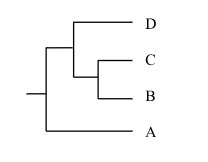 | |
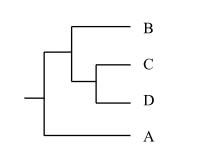 | |
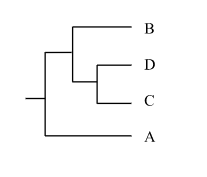 | |
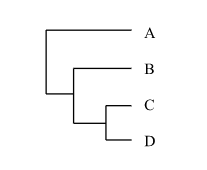 |
Question 45 Explanation:
The correct answer is (A). The phylogenetic tree in (A) shows the different pattern of evolutionary history. In answers (B), (C) and (D), species “C” and species “D” are sister taxa. In answer (A), species “C” and species “B” are sister taxa.
Question 46 |
Based on this phylogenetic tree, which statement is not true?
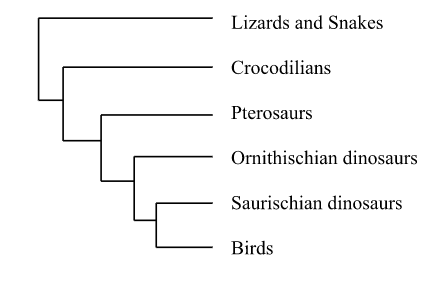
Crocodilians are a sister group to the group containing pterosaurs, ornithischian dinosaurs and saurischian dinosaurs. | |
Orithischian dinosaurs and saurischian dinosaurs are more closely related to birds than lizards and snakes. | |
The lineage leading to the lizards and snakes was the first to diverge from the other lineages. | |
Crocodilians are more closely related to ornithischian dinosaurs than lizards. |
Question 46 Explanation:
The correct answer is (D). Phylogenetic trees are branching diagrams that show the evolutionary history of a group of organisms. Phylogenetic trees show relationships between groups of organisms. These relationships are shown as branch points, where each branch point represents the divergence of two evolutionary lineages from a common ancestor. Sister taxa are groups of organisms that share an immediate common ancestor. This tree shows that crocodilians are more closely related to lizards and snakes, than to ornithischian dinosaurs, which are not adjacent to the crocodilians on the tree.
Question 47 |
Which of the following lists the hierarchical classification system from most to least inclusive?
Domain, Kingdom, Phylum, Class, Order, Family, Genus, Species | |
Phylum, Domain, Kingdom, Class, Order, Family, Genus, Species | |
Domain, Species, Genus, Family, Order, Class, Phylum, Kingdom | |
Kingdom, Phylum, Class, Order, Family, Genus, Species, Domain |
Question 47 Explanation:
The correct answer is (A). Domain is the most inclusive category, and species is the least.
Question 48 |
Which domain has the following characteristics:
- Single-celled
- No internal membranes
- May be aerobic or anaerobic
- Contain peptidoglycan in their thick, rigid cell walls
- No introns
Domain Archaea | |
Domain Bacteria | |
Domain Eukarya | |
Domain Prokarya |
Question 48 Explanation:
The correct answer is (B). Domain Bacteria has the characteristics described. Domain Archaea differs in that it may Archaean cells contain introns in some genes and they do not have peptidoglycan. Domain Eukarya includes all organisms with a nucleus, internal organelles and no peptidoglycan. Eukarya includes the following kingdoms: Protista (a polyphyletic grouping), Fungi, Plantae, and Animalia. Prokarya was the taxon that contained all prokaryotic organisms, has been split into two domains: Archaea and Bacteria.
Question 49 |
Which kingdom has the following characteristics:
- May be either heterotrophs or autotrophs
- May move by a variety of methods including pseudopods, cilia or flagella
- Some carry serious diseases such as malaria
- Include the widest variety of eukaryotic organisms
Animalia | |
Fungi | |
Plantae | |
Protista |
Question 49 Explanation:
The correct answer is (D). Kingdom Protista have the characteristics listed above. Kingdom Animalia are all heterotrophic and do not move by the same mechanisms. Kingdom Fungi are also heterotrophic and immobile. Kingdom Plantae are immobile and most are autotrophic.
Once you are finished, click the button below. Any items you have not completed will be marked incorrect.
There are 49 questions to complete.
|
List |
Next Practice Test:
Ecology >>
AP Biology Main Menu >>
